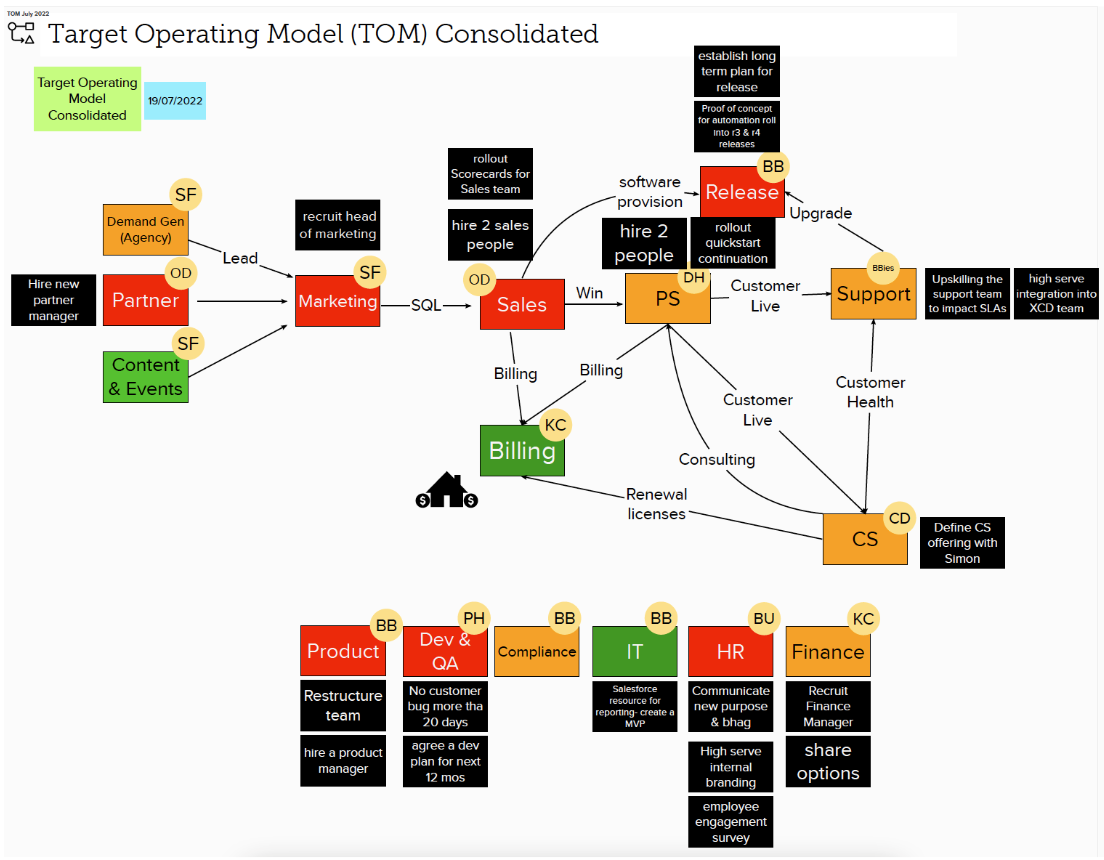You’re sitting in an endless Executive meeting. Every week it’s the same. Each team member feels compelled to report the status of their function at great length. And run through every KPI. Perhaps this justifies their existence, but is it really necessary? There must be a better way.
Right, time to bin the endless status updates. Enter the Target Operating Model — or TOM if you want to sound like you know what you’re talking about.
It’s one picture. That’s it. A brutally honest snapshot of how value actually moves through your business — who owns what, what’s humming, and what’s broken. Forget the 20-slide decks and vanity KPIs; this thing cuts through the noise.
Once you’ve got your TOM up on the wall, those long, soul-sucking exec meetings suddenly turn into focused problem-solving sessions. You’ll finally stop arguing about whose spreadsheet is right and start fixing what’s actually slowing you down.
What is a Target Operating Model?
The Target Operating Model — or TOM — isn’t another fancy framework dreamt up by consultants with too much time on their hands. It’s your business on one page: how value actually flows from a lead to cash in the bank.
Think of it as your company’s X-ray. It shows every key function — Marketing, Sales, Delivery, Customer Success, Finance — and the support teams keeping the whole machine running. You can see, in black and white, who owns what, what’s working, and what’s jammed up.
It borrows the best bits from Shannon Susko’s Key Function Flow Map, Porter’s Value Chain, and the Scaling Up Functional Accountability Chart — but strips out the jargon. The result? A brutally clear, visual map of how your business really works, without the MBA fluff.
Establishing ownership
Once you’ve sketched out the main flow — the journey from lead to cash — it’s time to make one thing crystal clear: who actually owns what.
Forget the org chart. That’s about hierarchy, not accountability. In TOM, every box — Marketing, Sales, Ops, Finance, HR, whatever — needs one name. No committees, no “shared responsibility”, no hiding. If a box doesn’t have a name, that’s a gap. If someone’s in three boxes, that’s fine — at least it’s explicit.
This step sparks the best kind of argument. Suddenly, the exec team has to talk about who really owns the bits that matter most to customers and staff. You’ll surface overlaps, finger-pointing, and the odd “hang on, I thought you did that” moment. Perfect. That’s how accountability starts — in the uncomfortable but honest conversations about ownership.
Working out the status of each function
Next comes the fun bit — colouring in. Once every function has an owner, get the team together and RAG the lot: Red, Amber, or Green.
And no, this isn’t “self-grading in private.” Everyone does it together. You’ll get friction — good. That’s where the truth lives. Marketing might think they’re flying (Green), while Ops and Finance quietly roll their eyes. That tension? That’s gold. It’s the moment where you stop pretending and start seeing what’s actually happening.
The point isn’t to make every box Green — it’s to agree where the system’s broken. The Reds and Ambers are where the business is bleeding time, cash, or sanity. Talk about those. Fix those. And for the love of god, stop wasting everyone’s time on the Greens. They’re fine. Leave them alone and move on.
Identifying upstream issues

This is where TOM starts earning its keep. Let’s say your Support team’s Amber. Everyone’s moaning about slow response times and unhappy customers. Easy to blame Support, right?
Not so fast. Work the flow backwards and you usually find the real problem sits upstream. In one client’s case, Support were drowning — but only because Sales were flogging deals to anyone with a pulse. Why? Because Marketing wasn’t feeding Sales enough decent leads. So Sales went wide, and Support paid the price.
That’s the power of TOM — it connects the dots. Suddenly, “Support is Amber” isn’t a witch hunt; it’s a signal. You see that fixing Support actually starts with fixing Marketing. Once the team gets that, the conversation shifts from blame to problem-solving. You stop patching symptoms and start unblocking flow.
Identifying metrics to measure
Here’s where the TOM gets properly nerdy — in a good way. Between every function, something flows: leads, orders, invoices, customers, cash. Those are your widgets. Measure them.
For example: between Marketing and Sales, it’s SQLs — Sales Qualified Leads. Between Sales and Ops, it might be signed contracts. Between Ops and Finance, completed projects or invoices raised. Each widget is a handoff, a measurable bit of value moving through the system.
Once you know your widgets, you can stop arguing about revenue targets and start working out the flow that actually drives them. If you want to bill £100 million next year, how many SQLs do you need to hit that? How many signed deals? How many projects shipped? Break it down to the month, the week, even the day.
Suddenly, Marketing knows it needs to generate 60 SQLs a month instead of 20. Sales knows what “enough” really looks like. You’re not just guessing at targets anymore — you’re running your business like a system, not a spreadsheet.
Working out tactical actions
Now that you’ve got your Reds and Ambers staring you in the face, it’s time to do something about them. Enter the black boxes — your 90-day commitments. Each one’s a clear, outcome-driven action that moves a function closer to Green.
Keep it tight. No long wish lists, no woolly “improve communication” rubbish. Five boxes max per function, each with initials next to it so everyone knows who’s on the hook. And make them outcomes, not chores — “Finance manager hired, onboarded, and delivering month-end packs” beats “Hire finance manager” every time.
These black boxes are where the talk turns into traction. They give your leadership team a visible scoreboard — you can literally see progress building quarter by quarter. And because TOM is a team sport, the whole exec crew owns the result. When one box goes Red, the rest lean in to fix it. That’s how you build momentum that actually lasts.
Focusing on the things that matter
Once your TOM’s up and running, don’t keep it locked away like some secret management relic. Get it on the wall. Take it to your next town hall or All Hands and say, “Here’s what’s broken — and here’s what we’re fixing next.”
That honesty is rocket fuel. Suddenly the front line sees that leadership gets it. The map matches their reality. You’ll stop hearing “management’s out of touch” and start hearing “finally, someone’s fixing the right stuff.”
And when you keep updating it every quarter — new colours, new black boxes, new wins — your team starts to feel the rhythm. They see progress. They know what good looks like and how their work moves the needle. That’s focus. That’s momentum.
Next steps:
• Build your TOM (start simple — 5 boxes, 1 flow).
• RAG it as a team. Don’t sugar-coat it.
• Add your black boxes — five clear 90-day wins.
• Share it. Make it visible.
Need a hand getting started? Grab the TOM Field Guide — it walks you step-by-step through building and running your own live model.
Your business doesn’t need another meeting. It needs a map. Build it, share it, and watch your exec team finally focus on what bloody matters.
Written by business coach and leadership coaching expert Dominic Monkhouse. Contact him to schedule a call here. You can order your free copy of his new book, Mind Your F**king Business here.

